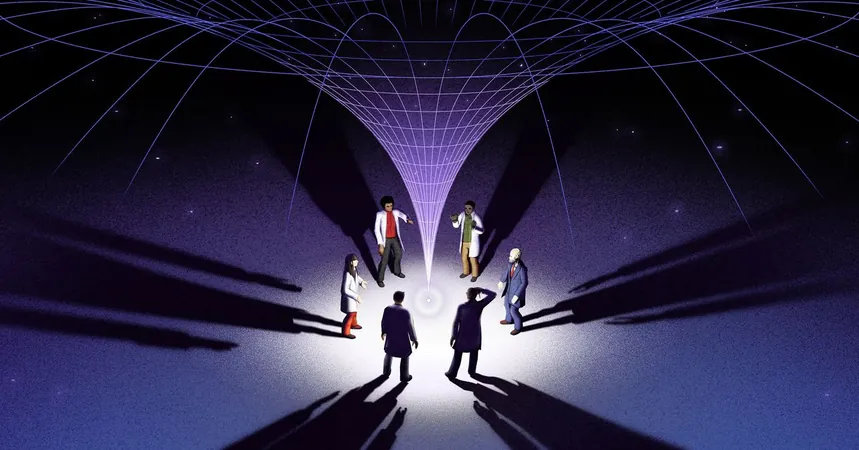
Unlocking the Mysteries of Quantum Gravity: Are Singularities More Than Just Math?
2025-07-20
Author: Jessica Wong
The Cosmic Enigma: Black Holes and the Birth of the Universe
Imagine two profound mysteries that baffle physicists: the moment the universe came into existence and the heart of a black hole. These enigmatic points, known as singularities, defy our understanding of space and time, hinting at a deeper truth beyond our current scientific frameworks.
Einstein’s Theory and its Limitations
Rooted in Einstein's general theory of relativity, singularities arise when dense matter warps the space-time fabric to an infinite degree, leading to incomprehensible gravitational forces. However, many physicists regard these singularities not as real phenomena but as 'mathematical artifacts'—shortcomings of relativity in extreme conditions.
The Ongoing Quest for Quantum Gravity
As physicists strive to marry general relativity with quantum mechanics, the challenge of singularities persists. Roger Penrose famously demonstrated in the 1960s that singularities could materialize even in an empty universe, a finding that set the stage for further research. More recent works indicate that even realistic, quantum-influenced universes are not immune to these mathematical curiosities.
The Historical Journey: From Schwarzschild to Black Holes
The concept of singularities dates back to Karl Schwarzschild in 1916, who revealed how a singularity forms under specific conditions. His discovery paved the way for the acceptance of black holes as real objects, though it took years for scientists to fully embrace this unfathomable idea.
Penrose’s Pivotal Proof
Penrose’s pivotal work in 1965 radically shifted the conversation. His two fundamental assumptions—about light cannot escape certain trapped surfaces—were revolutionary. He proved that light rays inevitably meet their end in a singularity, presenting a new type of singularity distinct from the Schwarzschild solution.
The Singularity Theorem Expands
Stephen Hawking expanded on this by linking singularities to the Big Bang, proposing that the universe must have originated from one such point. However, whether these singularities actually exist in our universe remains a hot topic of debate.
The Need for Quantum Theory
General relativity, as a classical theory, fails to account for the dual states of quantum matter, leading to predictability issues at singularities. Physicists believe a quantum theory of gravity is necessary to unlock the true fate of matter in extreme environments.
Layering the Quantum Onion: A Deep Dive
The quest for quantum gravity is akin to peeling an onion, with each layer representing a theory that brings us closer to understanding reality. Initially, physicists like Penrose focused on classical approximations, but researchers like Aron Wall have begun to explore deeper, more nuanced theories that include quantum effects.
The Recent Breakthroughs
Recent findings by physicists like Raphael Bousso show that even when incorporating quantum facets such as negative energy, singularities persist. This suggests that these mathematical curiosities cannot simply be brushed aside.
The Uncertainty of Existence
Despite growing evidence supporting singularities, their existence in our actual universe remains unverified. Some theorists speculate that what appears to be a singularity might connect to alternate universes through black holes, or that our universe rebounded from a previous state in a 'Big Bounce' rather than originating from a singularity.
Glimmers of Hope: The Future of Quantum Gravity
Researchers continue to explore these captivating possibilities. Some believe a new theory of quantum gravity might redefine singularities, transforming them from cosmic dead ends to zones of profound understanding where traditional concepts of space and time break down.
Conclusion: The Journey Ahead
The ongoing exploration of singularities is reshaping our comprehension of the universe. As we peel back the layers of quantum gravity, we may uncover surprising truths about the fundamental nature of reality—and perhaps redefine the very concepts of time and space in the process.



 Brasil (PT)
Brasil (PT)
 Canada (EN)
Canada (EN)
 Chile (ES)
Chile (ES)
 Česko (CS)
Česko (CS)
 대한민국 (KO)
대한민국 (KO)
 España (ES)
España (ES)
 France (FR)
France (FR)
 Hong Kong (EN)
Hong Kong (EN)
 Italia (IT)
Italia (IT)
 日本 (JA)
日本 (JA)
 Magyarország (HU)
Magyarország (HU)
 Norge (NO)
Norge (NO)
 Polska (PL)
Polska (PL)
 Schweiz (DE)
Schweiz (DE)
 Singapore (EN)
Singapore (EN)
 Sverige (SV)
Sverige (SV)
 Suomi (FI)
Suomi (FI)
 Türkiye (TR)
Türkiye (TR)
 الإمارات العربية المتحدة (AR)
الإمارات العربية المتحدة (AR)